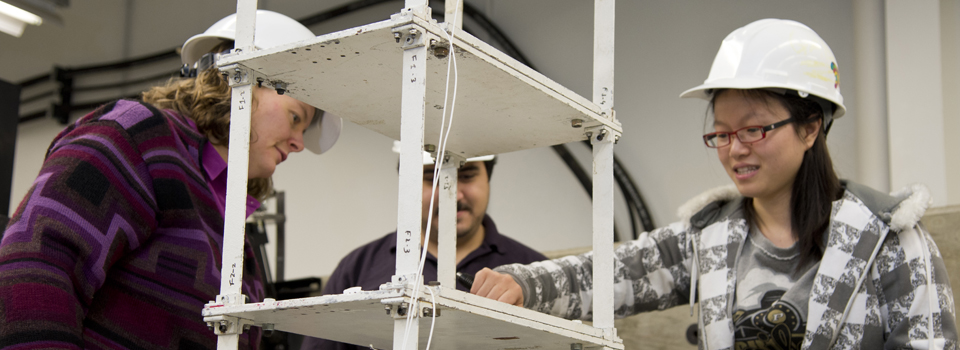Simulations aiding study of earthquake dampers for structures
Simulations aiding study of earthquake dampers for structures
| Author: | Emil Venere |
|---|---|
| Magazine Section: | Innovate |
| College or School: | CoE |
| Article Type: | Issue Feature |
| Feature Intro: | Researchers have demonstrated the reliability and efficiency of “real-time hybrid simulation” for testing a type of powerful damping system that might reduce structural damage and injuries during earthquakes. |
The magnetorheological-fluid dampers are shock-absorbing devices containing a liquid that becomes far more viscous when a magnetic field is applied.
“It normally feels like a thick fluid, but when you apply a magnetic field it transforms into a peanut-butter consistency, which makes it generate larger forces when pushed through a small orifice,” says Shirley Dyke, professor of mechanical engineering and civil engineering.
This dramatic increase in viscosity enables the devices to exert powerful forces and to modify a building’s stiffness in response to motion during an earthquake. The magnetorheological-fluid dampers, or MR dampers, have seen limited commercial use and are not yet being used routinely in structures.
Research led by Dyke and doctoral students Gaby Ou and Ali Ozdagli has now shown real-time hybrid simulations are reliable in studying the dampers. The research is affiliated with the National Science Foundation's George E. Brown Jr. Network for Earthquake Engineering Simulation (NEES), a shared network of laboratories based at Purdue.
Dyke and her students are working with researchers at the Harbin Institute of Technology in China, home to one of only a few large-scale shake-table facilities in the world.
Findings were discussed during the NEES Quake Summit 2013 in August. A research paper also was presented in May during a meeting in Italy related to a consortium called SERIES (Seismic Engineering Research Infrastructures for European Synergies). The paper was authored by Ou, Dyke, Ozdagli, and researchers Bin Wu and Bo Li from the Harbin Institute.
“The results indicate that the real-time hybrid simulation concept can be considered as a reliable and efficient testing method,” Ou says.
The simulations are referred to as hybrid because they combine computational models with data from physical tests.
“You have physical models and computational models being combined for one test,” Dyke says.
Real-time testing provides answers
Researchers are able to perform structural tests at slow speed, but testing in real-time – or the actual speed of an earthquake – sheds new light on how the MR dampers perform in structures. The real-time ability has only recently become feasible due to technological advances in computing.
“Sometimes real-time testing is necessary, and that’s where we focus our efforts,” says Dyke, who organized a workshop on the subject to be held during the NEES meeting in Reno. “This hybrid approach is taking off lately. People are getting very excited about it.”
Ozdagli also presented related findings at the 2013 Conference of the ASCE Engineering Mechanics Institute in Evanston, Ill.
The simulations can be performed in conjunction with research using full-scale building tests. However, there are very few large-scale facilities in the world, and the testing is time-consuming and expensive.
“The real-time hybrid simulations allow you to do many tests to prepare for the one test using a full-scale facility,” Dyke says. “The nice thing is that you can change the numerical model any way you want. You can make it a four-story structure one day and the next day it’s a 10-story structure. You can test an unlimited number of cases with a single physical setup.”
The researchers presented two abstracts during the Reno meeting. One focused on how the simulation method has been improved and the other described the overall validation of real-time hybrid simulations.
To prove the reliability of the approach the researchers compare pure computational models, pure physical shake-table tests and then the real-time hybrid simulation. Research results from this three-way comparison demonstrate that the hybrid simulations are accurate.
Ou has developed a mathematical approach to cancel out “noise” that makes it difficult to use testing data. She combined mathematical tools for a new “integrated control strategy” for the hybrid simulation.
“She found that by integrating several techniques in the right mix you can get better performance than in prior tests,” Dyke says.
The researchers have validated the simulations.
“It’s a viable method that can be used by other researchers for many different purposes and in many different laboratories,” Dyke says.
Much of the research is based at Purdue’s Robert L. and Terry L. Bowen Laboratory for Large-Scale Civil Engineering Research and has been funded by the National Science Foundation through NEES. A portion is supported by the Sohmen Fund, an endowment established by Purdue alumnus Anna Pao Sohmen to facilitate faculty and student exchange with the Harbin Institute of Technology and Ningbo University. The fund is managed by International Programs at Purdue.

Comments